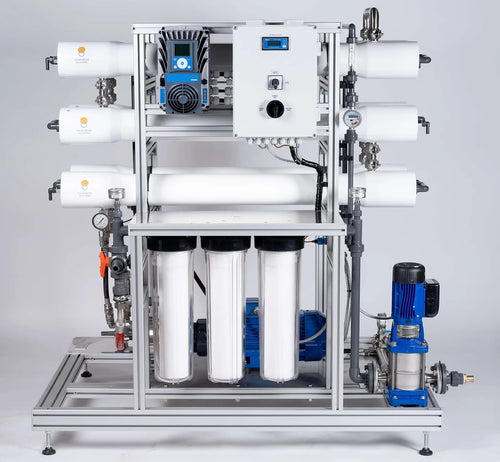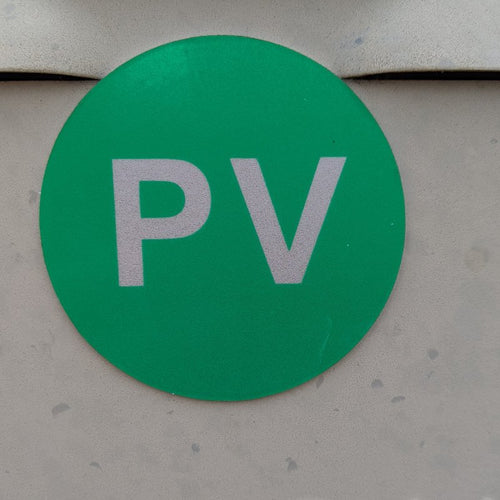The solar bore pump
Windmills were once ubiquitous in the rural landscape, but you might have noticed something new appearing in their place. Increasingly farmers are choosing to replace old windmills and equip new bores and dams with solar panels instead. Like windmills, solar panels use renewable energy and have very low running costs. Solar panels and pumps, however, are now cheaper to set up and to maintain, giving them the advantage over windmills for remote applications. Even where access to grid electricity is available, with increasing electricity prices, the use of a free energy source is desirable. And they are far more practical than diesel or petrol pumps which must be attended regularly for starting, stopping, maintaining and refuelling.
The disadvantage of a solar pump, like a windmill, is that the power source is not always available on demand. A windmill will only pump water while the wind is blowing, and similarly, solar panels will only power a pump while the sun is shining. This intermittent supply can be managed using tanks and troughs to store water while the energy source is available. Tanks are often placed at high-points on the property, so that gravity can be used to distribute water as required. Alternatively, the panels could be set up with battery storage so that the pump can operate continuously.
Setting up a solar pump may sound complex, but actually it is very simple and with a few instructions, anyone can make use of renewable energy to pump water on the farm. Most suppliers of solar panels and pumps will provide assistance to size the pump and basic instructions for installation.
Whether you need to pump water to provide water for stock, or to irrigate paddocks, you need to choose the right pump for the amount of water and the distance and height you need to move the water. No matter what type of pump, whether its powered by solar, fuel or electricity, you will need to know three things in order to select the correct pump. The first is the volume of water you need to move, second the total “pressure head”, which is a combination of the height and any resistance of the pipework, and finally, the “suction head”, which is the distance from the pump to the water level. A pump supplier can assist with selecting a suitable pump when provided with these three factors.
The first step is to work out the volume you need to pump. For cattle you can assume they will drink 100 L per day. For example, to provide water for two cows, the pump would need to be capable of moving 200 L per day. Note that the pump will only be available while the sun is shining on the solar panels, which in winter may be only 6 hours per day, in which case the pump would need to achieve a flowrate of 200 L in 6 hours, or 33 L per hour.
The total head that the pump needs to move the water will depend on both the height and the pipework to be used. The height can be determined roughly using GPS devices or from contour maps, to the nearest 10 m if possible. Unless it’s very complicated, the pipework typically has only a minor contribution to the total head. Again, a pump supplier can assist with these calculations.
Installation of the pump and solar panels will require a suitable location with maximum possible sun exposure and a northerly aspect (in the Southern Hemisphere). The ideal angle for the panels depends on the season, but on average, the latitude of the location is a good angle to use (unless the angle is to be adjusted with the seasons and in that case, the ideal angle can be worked out from the sun angle at each season). A sturdy frame should be constructed to support the panels if this is not provided as part of the package. Also consider fencing the panels and pumps to prevent damage from curious cattle, they tend to use anything as a scratching post.
A solar pump is a good alternative to windmills, electric and fuel pumps because it is cheaper to operate and requires minimal maintenance once installed. A pump supplier can assist with calculations to determine the size of pump and panels required for a any application. While they may seem complicated, it is worth investigating if a solar pump is suitable as they are now relatively simple to install and operate.
The disadvantage of a solar pump, like a windmill, is that the power source is not always available on demand. A windmill will only pump water while the wind is blowing, and similarly, solar panels will only power a pump while the sun is shining. This intermittent supply can be managed using tanks and troughs to store water while the energy source is available. Tanks are often placed at high-points on the property, so that gravity can be used to distribute water as required. Alternatively, the panels could be set up with battery storage so that the pump can operate continuously.
Our bore is in a low area of our property, but the bore is relatively shallow. We chose a pump that could pump the water out of the bore and up to the highest point on our property. We've installed a tank there and will gravity feed water to where its needed.
Setting up a solar pump may sound complex, but actually it is very simple and with a few instructions, anyone can make use of renewable energy to pump water on the farm. Most suppliers of solar panels and pumps will provide assistance to size the pump and basic instructions for installation.
Whether you need to pump water to provide water for stock, or to irrigate paddocks, you need to choose the right pump for the amount of water and the distance and height you need to move the water. No matter what type of pump, whether its powered by solar, fuel or electricity, you will need to know three things in order to select the correct pump. The first is the volume of water you need to move, second the total “pressure head”, which is a combination of the height and any resistance of the pipework, and finally, the “suction head”, which is the distance from the pump to the water level. A pump supplier can assist with selecting a suitable pump when provided with these three factors.
The first step is to work out the volume you need to pump. For cattle you can assume they will drink 100 L per day. For example, to provide water for two cows, the pump would need to be capable of moving 200 L per day. Note that the pump will only be available while the sun is shining on the solar panels, which in winter may be only 6 hours per day, in which case the pump would need to achieve a flowrate of 200 L in 6 hours, or 33 L per hour.
The total head that the pump needs to move the water will depend on both the height and the pipework to be used. The height can be determined roughly using GPS devices or from contour maps, to the nearest 10 m if possible. Unless it’s very complicated, the pipework typically has only a minor contribution to the total head. Again, a pump supplier can assist with these calculations.
Installation of the pump and solar panels will require a suitable location with maximum possible sun exposure and a northerly aspect (in the Southern Hemisphere). The ideal angle for the panels depends on the season, but on average, the latitude of the location is a good angle to use (unless the angle is to be adjusted with the seasons and in that case, the ideal angle can be worked out from the sun angle at each season). A sturdy frame should be constructed to support the panels if this is not provided as part of the package. Also consider fencing the panels and pumps to prevent damage from curious cattle, they tend to use anything as a scratching post.
A solar pump is a good alternative to windmills, electric and fuel pumps because it is cheaper to operate and requires minimal maintenance once installed. A pump supplier can assist with calculations to determine the size of pump and panels required for a any application. While they may seem complicated, it is worth investigating if a solar pump is suitable as they are now relatively simple to install and operate.
Have you considered using a solar pump? Or other solar devices on your property?





















Yes and no. I recently installed a very small submersible pump to supply water to my garden from a nearby pond that is a couple of metres lower in the landscape.
I looked into powering it with a solar panel but after getting nothing back from my enquiry from the supplier I decided just to use a small, sealed battery.
Like you, this was a small experiment just to see if it is feasible. It works, just, but not well enough to pump into a tank high enough to gravity-feed to the garden. It helped to orient my mind to the many issues involved.
In the meantime I have installed a long pipe to syphon from another pond, further away but slightly above the garden elevation. Longer term a proper solar pump with a reservoir at sufficient elevation to gravity feed over a wider area will be one of my goals. We have a small stream that runs across our property, with a catchment of 15 hectares in the adjoining property. So we have an abundance of water in the winter and not very much in the summer when it is most needed. I think that the productivity of the farm would be greatly helped with solar pump and sufficient storage.
Leave a comment